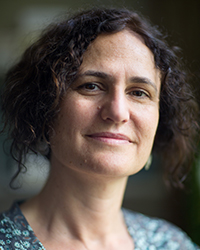Baylor Lecture Series in Mathematics
The aim of this lecture series is to bring in mathematicians who are nationally and internationally recognized for their research and contributions to mathematics. Funds were made available for this lecture series, started in 2007, by the Baylor administration; special thanks to Dean Lee Nordt and Dean Kenneth Wilkins of the College of Arts and Sciences for their generous support.
Fifteenth Annual Baylor Lecture Series in Mathematics
Speaker: Gigliola Staffilani
Professor Gigliola Staffilani, the Abby Rockefeller Mauze Professor of Mathematics at MIT, will be the speaker in the 15th Baylor Lecture Series in Mathematics when she visits Baylor University on January 24-25, 2024.
Gigliola Staffilani is an analyst, and her research is on dispersive nonlinear Partial Differential Equations (PDE). These equations, such as the Schrödinger equation, are fundamental in physics and they are proposed as models for a variety of wave phenomena. Staffilani is particularly interested in understanding mathematically how the macroscopic wave solutions of a certain dispersive PDE are derived from the physical interactions of particles involved in the phenomenon that the PDE is supposed to describe. She also studies how the nonlinear interactions between these wave solutions create fascinating objects such as rogue waves, solitons and singularities. In order to analyze in depth these objects she uses a variety of mathematical tools that come from the interaction of harmonic and Fourier analysis, analytic number theory, dynamical systems, probability, geometry and numerical analysis.
Dr. Staffilani is an Elected Member of the National Academy of Sciences. She received M.S. and Ph.D. degrees from the University of Chicago in 1991 and 1995 respectively. Following a Szegö Assistant Professorship at Stanford, Staffilani had faculty appointments at Stanford, Princeton, and Brown, before joining the MIT mathematics faculty in 2002. While at Stanford, she received the Harold M. Bacon Memorial Teaching Award in 1997 and was given the Frederick E. Terman Award for young faculty in 1998. She was a Sloan fellow from 2000 to 2002. In 2013 she was elected member of the Massachusetts Academy of Science and a fellow of the AMS, and in 2014 fellow of the American Academy of Arts and Sciences. In 2017 she received a Guggenheim fellowship and a Simons Fellowship in Mathematics. As a member of the MIT Math Department’s edX group, Staffilani received the inaugural MITx Prize for Teaching and Learning in MOOCs by the MIT Office of Digital Learning. In 2018, Staffilani received the Earll M. Murman Award for Excellence in Undergraduate Advising, by the MIT Presidential Task Force on the Undergraduate Educational Commons. She is also the recipient of the Guglielmo Marconi Medal, Universit´a di Bologna, 2020, of the MIT Committed to Care Award in 2020, and of the Premio Luigi e Wanda Amerio, Istituto Lombardo, Accademia di Scienze e Lettere, 2021.
For a poster advertising Professor Staffilani's public lecture, click here.
Dr. Staffilani's lectures and abstracts, with dates and venues, are:
PUBLIC LECTURE:
A small window on wave turbulence theory
Wednesday, January 24, 2024, at 4:30 pm - Cashion Building CASHN 311
Abstract: Wave turbulence theory is a vast subject and its goal is to formulate for us a global picture of wave interactions. Phenomena involving interactions of waves happen at different scales and in different media: from gravitational waves to the waves on the surface of the ocean, from our milk and coffee in the morning to infinitesimal particles that behave like wave packets in quantum physics. These phenomena are difficult to study in a rigorous mathematical manner, but because of this challenge, mathematicians have developed interdisciplinary approaches that are powerful and beautiful. I will describe some of these approaches and I will outline along the way questions that remain open in spite of the great progress already made.
COLOQUIUM LECTURE:
The Schrödinger equations as inspiration of beautiful mathematics
Thursday, January 25, 2024, at 3:30 pm - Sid Richardson Building SDRICH 344
Abstract: In the last two decades great progress has been made in the study of dispersive and wave equations. Over the years the toolbox used in order to attack highly nontrivial problems related to these equations has developed to include a collection of techniques: Fourier and harmonic analysis, analytic number theory, math physics, dynamical systems, probability and symplectic geometry. In this talk I will introduce a variety of results using as model problem mainly the periodic 2D cubic nonlinear Schrödinger equation. I will start by giving a physical derivation of the equation from a quantum many-particles system, I will introduce periodic Strichartz estimates along with some remarkable connections to analytic number theory, I will move on to the concept of energy transfer and its connection to dynamical systems, and I will end with some results following from viewing the periodic nonlinear Schrödinger equation as an infinite dimensional Hamiltonian system.
